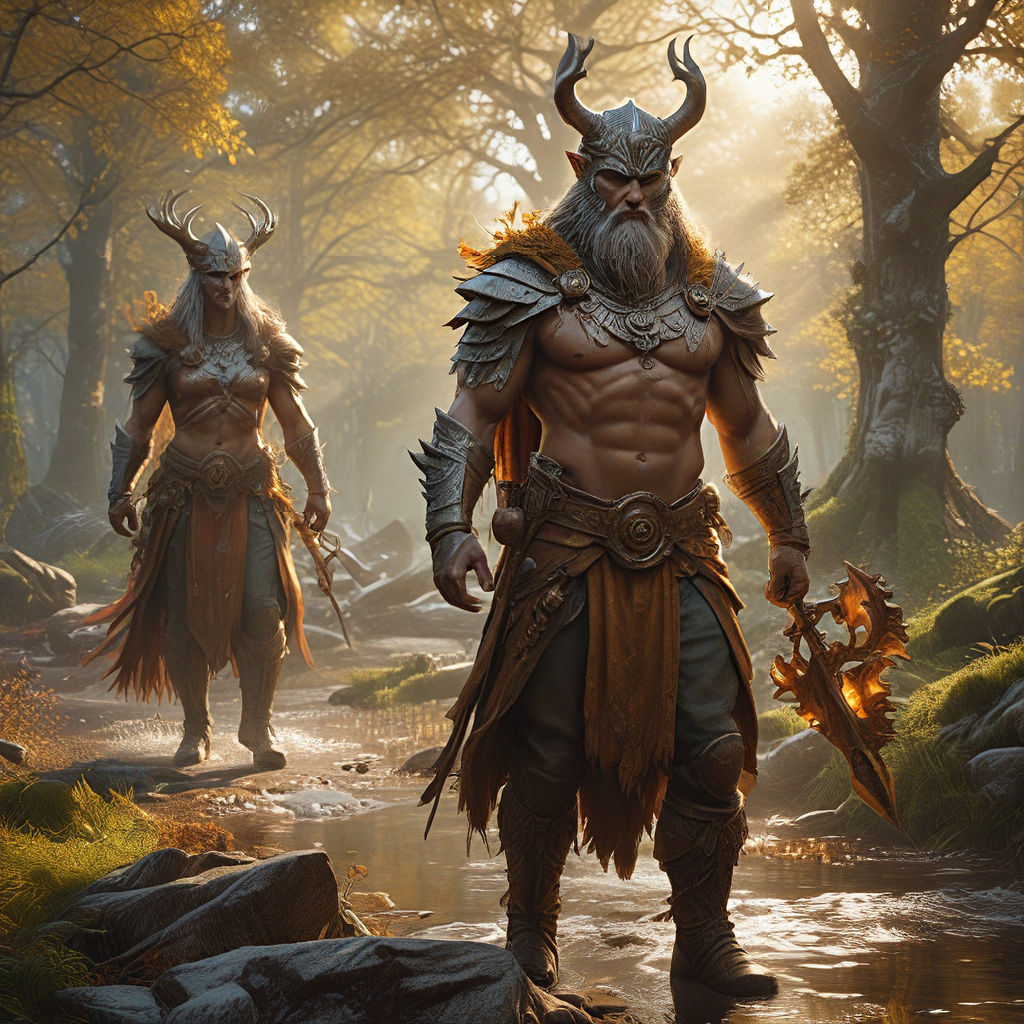Baltic Mythology: A Tapestry of Protection and Strength
The Baltic region, encompassing modern-day Lithuania, Latvia, and Estonia, boasts a rich and vibrant mythology steeped in nature, resilience, and the enduring spirit of its people. Baltic mythology, rich in symbolism and captivating narratives, offers a fascinating glimpse into the beliefs and values of this ancient culture. Central to Baltic mythology is the enduring theme of protection, not just against physical threats, but also against the uncertainties of life itself. This profound desire for protection is woven into the fabric of their beliefs, reflected in powerful deities, awe-inspiring symbols, and rituals designed to secure well-being and ensure prosperity.
Beyond protection, the Baltic people venerated strength, both physical and spiritual. They found inspiration in the power of nature, recognizing its raw force and embracing its relentless cycle of life and renewal. This reverence for nature is embodied in the sacred symbols that pervade Baltic mythology, each carrying a unique significance and serving as a potent reminder of the interconnectedness of all things.
The Gods of Protection: Guardians of the Realm
In the pantheon of Baltic gods, several deities stand out as protectors, their roles intricately woven into the fabric of human existence. One of the most prominent figures is Perkūnas, the thunder god, whose thunderous voice echoes through the sky, signifying his power and dominion over the forces of nature. Perkūnas was believed to be a fierce protector, wielding his power to ward off evil spirits and ensure the fertility of the land.
Another important figure is Dievs, the sky god, who embodies the vastness and majesty of the heavens. Dievs was revered as a source of wisdom and justice, and his gentle presence provided a comforting sense of peace and stability. Laima, the goddess of fate, was entrusted with the destinies of individuals and communities, weaving the threads of life and determining their ultimate outcomes. By honoring Laima, the Baltic people sought to appease her and ensure a favorable destiny for themselves and their loved ones.
These powerful deities, each with their unique dominions and attributes, offered the Baltic people a sense of security and guidance. They were believed to watch over their communities, protecting them from harm and ensuring their well-being. This sense of protection was not just spiritual, but also practical, as these deities embodied the forces of nature that the Baltic people relied upon for survival.
Symbols of Strength: Embracing the Power of Nature
The Baltic people found inspiration in the natural world, recognizing its immense power and embracing its boundless energy. Their mythology is replete with symbols that represent the very essence of strength and resilience, reminding them of their connection to nature and the power that resides within them. These symbols were not mere ornaments, but potent reminders of the profound forces that shaped their lives and guided their actions.
The Tree of Life: A Symbol of Resilience and Rebirth
The Tree of Life, a ubiquitous symbol across many cultures, holds a special significance in Baltic mythology. This ancient symbol, often depicted as a majestic oak or birch, represents the enduring cycle of life, death, and rebirth. The tree's deep roots symbolize the connection to the earth, its strong trunk represents resilience, and its branches reaching towards the heavens signify aspirations and growth.
The Tree of Life is a powerful reminder of the interconnectedness of life and the enduring spirit that resides within every living thing. It represents the ability to overcome adversity, to rise from the ashes of hardship, and to embrace the transformative power of nature. Throughout the ages, the Tree of Life has been a source of inspiration and hope for the Baltic people, reminding them of their own inherent strength and ability to endure.
The Sun Wheel: Radiating Light and Vitality
The Sun Wheel, a symbol of immense power and life-giving energy, stands as a testament to the Baltic people's reverence for the sun. This symbol, often depicted as a stylized sun with rays emanating from its center, represents the sun's journey across the sky, bringing warmth, light, and life to the world.
The Sun Wheel is a powerful symbol of vitality, representing the life-giving force that nourishes all living things. It symbolizes the cyclical nature of time, the constant renewal that brings forth new life and ensures the perpetuation of existence. The Sun Wheel was not just a symbol of the sun, but a representation of the divine spark within every individual, a reminder of the potential for growth, renewal, and enduring strength.
The Swastika: A Misunderstood Symbol of Good Fortune
The swastika, a symbol with a long and complex history, holds a unique significance in Baltic mythology. Contrary to its modern association with Nazi ideology, the swastika, in its original form, was a symbol of good fortune, prosperity, and the sun's life-giving energy. In Baltic mythology, the swastika was often depicted as a four-armed cross, each arm ending in a right angle, symbolizing the sun's journey across the sky and its cyclical nature.
The swastika was seen as a protective symbol, capable of warding off evil spirits and bringing blessings upon those who wore it or carried it with them. It was frequently incorporated into decorative patterns on clothing, household items, and sacred objects, serving as a constant reminder of the divine protection and good fortune that the Baltic people sought. However, it's crucial to remember that the swastika's meaning has been distorted by its appropriation by Nazi ideology. It is important to understand the original, pre-Nazi, context and significance of the swastika, recognizing its positive symbolism in Baltic mythology.
The Snake: A Symbol of Wisdom and Transformation
In Baltic mythology, the snake, a creature often regarded with fear and suspicion in other cultures, holds a special place as a symbol of wisdom, transformation, and the cyclical nature of life. Snakes were seen as powerful beings, possessing knowledge of hidden secrets and the ability to shed their skin, signifying a renewal of life and a transformation of the self.
The snake's ability to move through the earth, connecting the underworld with the surface world, symbolized the passage between life and death, a concept central to Baltic beliefs. The snake's venomous bite was often seen as a form of protection, capable of warding off evil spirits and protecting those who invoked its power. The snake's connection to the earth and its regenerative powers made it a powerful symbol of resilience and the potential for renewal.
The Wolf: Embodying Strength and Courage
The wolf, a creature revered for its strength, cunning, and resilience, occupies a prominent role in Baltic mythology. Wolves were seen as powerful guardians of the forest, embodying the wild, untamed spirit of nature and representing the raw power that resided in the natural world. Their ability to hunt and survive in harsh conditions made them a symbol of strength, courage, and adaptability.
In some Baltic myths, wolves are depicted as protectors of the people, guiding them through the wilderness and defending them against harm. Their howling cries were often interpreted as a communication with the gods, seeking guidance and protection. As guardians of the forest and protectors of the people, wolves played an important role in shaping the beliefs and values of the Baltic people.
The Bear: Guardians of the Forest and the Hunt
The bear, a powerful and majestic creature, represents the strength and wisdom of the forest in Baltic mythology. Bears were considered to be wise and powerful protectors of the natural world, embodying the balance of nature and the forces that governed the hunt. The bear's connection to the earth, its ability to hibernate during winter and awaken in the spring, symbolized the cyclical nature of life and the promise of renewal.
Bears were also seen as guardians of the forest, protecting its inhabitants from harm. They were revered as sacred animals and were often associated with the gods of the hunt, reflecting the importance of respect for the forest and its resources. The bear's strength and power served as a source of inspiration for the Baltic people, reminding them of the importance of respecting nature and embracing its powerful forces.
The Role of Ritual and Magic: Protecting the Physical and Spiritual
Baltic mythology is rich in rituals and magic, reflecting the people's belief in the power of the spirit world and their desire to seek protection and guidance from the deities. These rituals, often performed in conjunction with sacred symbols, were believed to have the power to influence events, ward off evil, and ensure prosperity.
One common practice was the use of amulets and charms, often crafted from natural materials and adorned with protective symbols. These objects were believed to provide a sense of security and ward off evil spirits. Ritual sacrifices, usually involving offerings of food, animals, or even humans, were also performed to appease the gods and ensure their favor. The Baltic people believed that through these rituals, they could connect with the supernatural world and secure the blessings of the gods.
Theories of Baltic Symbolism: Tracing the Roots of Sacred Meaning
The symbolism in Baltic mythology, like that of most ancient cultures, is deeply rooted in the natural world and the people's understanding of the forces that shaped their lives. Some scholars believe that the symbolism evolved from animistic beliefs, where natural objects and phenomena were imbued with spiritual power.
Other theories suggest that the symbolism has roots in Indo-European mythology, reflecting shared beliefs and practices among ancient cultures. The study of Baltic symbolism is a fascinating exploration of the human spirit's search for meaning and its attempts to understand the forces that govern existence. By deciphering the meaning of these symbols, we can gain a deeper understanding of the beliefs, values, and cultural heritage of the Baltic people.
FAQ
Q: What are some of the key themes in Baltic mythology?
A: Baltic mythology explores themes of protection, strength, nature, resilience, and the cyclical nature of life.
Q: What is the significance of the Tree of Life in Baltic mythology?
A: The Tree of Life, often depicted as a majestic oak or birch, represents the enduring cycle of life, death, and rebirth, symbolizing resilience and growth.
Q: What is the Sun Wheel and what does it symbolize?
**A: ** The Sun Wheel, a stylized sun with rays emanating from its center, represents the sun's journey across the sky, symbolizing vitality, renewal, and life-giving energy.
Q: Why is the swastika a controversial symbol?
A: The swastika's original meaning in Baltic mythology is different from its association with Nazi ideology. It symbolized good fortune and prosperity, but its appropriation by the Nazis has drastically altered its meaning for many.
Q: What role do rituals and magic play in Baltic mythology?
A: Rituals, including sacrifices, amulets, and charms, were believed to connect the people with the spirit world and provide protection and guidance.
Q: What are some theories about the origins of Baltic symbolism?
A: Theories suggest that Baltic symbolism evolved from animistic beliefs or has roots in Indo-European mythology, reflecting shared beliefs and practices.



